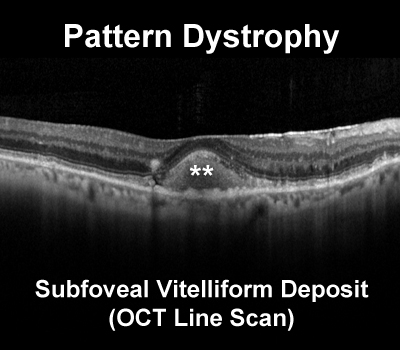
Pattern dystrophy is a type of dry age-related macular degeneration that involves mostly the very center of the macula. There are several types of pattern dystrophy. The most common pattern dystrophy is adult vitelliform dystrophy. The image with this text shows a pigmented spot in the very center of the macula (all images on this page are of the same patient taken on the same date). This deposit caused some vision loss in the patient (to 20/40). Pattern dystrophy is like age-related macular degeneration in that their are pigmented deposits that build up under the retina. It tends to present at a younger age, usually age 50 years to 60 years. Also, vision loss is usually minimal initially but can worsen with age. Many patients, like the on in the image, also have macular degeneration. Their are reticular pseudodrusen in this image (the little greenish dots) away from the very center of the macula.

The image with this text is of a patient with adult vitelliform macular dystrophy. The image shows the buildup of abnormal deposits under the retina in the center of the macula. Unlike typical dry macular degeneration where the buildup of material is below the retinal pigment epithelium, in pattern dystrophy, the buildup of material is above the pigment epithelium and directly beneath the retina (see asterisks on image). The nature of the subretinal material is not yet known nor the reason why it accumulated under the retina instead of under the RPE. Patients with pattern dystrophy can sometimes be mistakenly diagnosed as having wet AMD because of the material under the retina.

Pattern dystrophy has been associated with a few different genetic defects. Unlike age-related macular degeneration, pattern dystrophy is often genetic and passes through families in an autosomnal dominant pattern. That means half of the children of someone with pattern dystrophy will develop pattern dystrophy. It usually doesn’t present until after age 50. The FAF image with this text shows hyper-autofluorescence in the center of the macula from the subretinal material.